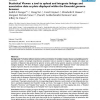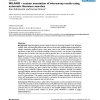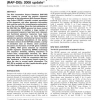BMCBI
2005
14 years 10 days ago
2005
Background: To facilitate efficient selection and the prioritization of candidate complex disease susceptibility genes for association analysis, increasingly comprehensive annotat...
BMCBI
2005
14 years 10 days ago
2005
Background: High-throughput genomic research tools are becoming standard in the biologist's toolbox. After processing the genomic data with one of the many available statisti...
BMCBI
2005
14 years 10 days ago
2005
Background: Current protein clustering methods rely on either sequence or functional similarities between proteins, thereby limiting inferences to one of these areas. Results: Her...
BMCBI
2005
14 years 10 days ago
2005
Background: Assignment of function to new molecular sequence data is an essential step in genomics projects. The usual process involves similarity searches of a given sequence aga...
BMCBI
2005
14 years 10 days ago
2005
Background: Computational protein annotation methods occasionally introduce errors. Falsepositive (FP) errors are annotations that are mistakenly associated with a protein. Such f...
BMCBI
2005
14 years 10 days ago
2005
Background: Cellular processes require the interaction of many proteins across several cellular compartments. Determining the collective network of such interactions is an importa...
INFORMATICALT
2007
14 years 10 days ago
2007
Semantic-based storage and retrieval of multimedia data requires accurate annotation of the data. Annotation can be done either manually or automatically. The retrieval performance...
SPEECH
2008
14 years 10 days ago
2008
In this paper, we study the impact of considering context information for the annotation of emotions. Concretely, we propose the inclusion of the history of user
NAR
2008
14 years 11 days ago
2008
The Rice Annotation Project Database (RAP-DB) was created to provide the genome sequence assembly of the International Rice Genome Sequencing Project (IRGSP), manually curated ann...
CORR
2007
Springer
14 years 12 days ago
2007
Springer
The aim of this paper is to propose an approach based on the concept of annotation for supporting design communication. In this paper, we describe a co-operative design case study...





